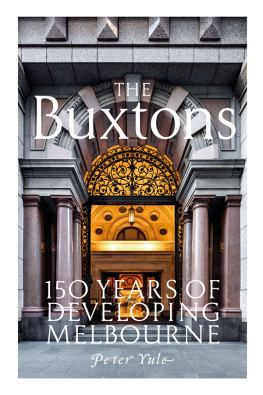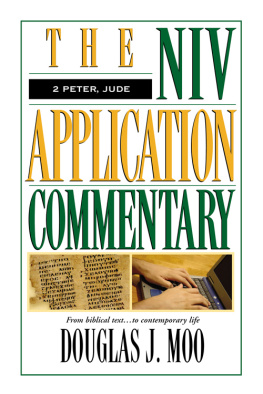Peter Yule - The Buxtons
Here you can read online Peter Yule - The Buxtons full text of the book (entire story) in english for free. Download pdf and epub, get meaning, cover and reviews about this ebook. publisher: Schwartz Publishing Pty. Ltd, genre: Non-fiction. Description of the work, (preface) as well as reviews are available. Best literature library LitArk.com created for fans of good reading and offers a wide selection of genres:
Romance novel
Science fiction
Adventure
Detective
Science
History
Home and family
Prose
Art
Politics
Computer
Non-fiction
Religion
Business
Children
Humor
Choose a favorite category and find really read worthwhile books. Enjoy immersion in the world of imagination, feel the emotions of the characters or learn something new for yourself, make an fascinating discovery.
- Book:The Buxtons
- Author:
- Publisher:Schwartz Publishing Pty. Ltd
- Genre:
- Rating:3 / 5
- Favourites:Add to favourites
- Your mark:
- 60
- 1
- 2
- 3
- 4
- 5
The Buxtons: summary, description and annotation
We offer to read an annotation, description, summary or preface (depends on what the author of the book "The Buxtons" wrote himself). If you haven't found the necessary information about the book — write in the comments, we will try to find it.
The Buxtons — read online for free the complete book (whole text) full work
Below is the text of the book, divided by pages. System saving the place of the last page read, allows you to conveniently read the book "The Buxtons" online for free, without having to search again every time where you left off. Put a bookmark, and you can go to the page where you finished reading at any time.
Font size:
Interval:
Bookmark:

Published by Nero,
an imprint of Schwartz Publishing Pty Ltd
Level 1, 221 Drummond Street
Carlton VIC 3053, Australia
www.nerobooks.com
Copyright Peter Yule 2018
Peter Yule asserts his right to be known as the author of this work.
ALL RIGHTS RESERVED.
No part of this publication may be reproduced, stored in a retrieval system, or transmitted in any form by any means electronic, mechanical, photocopying, recording or otherwise without the prior consent of the publishers.
9781760640088 (hardback)
9781743820407 (ebook)

Cover design by Tristan Main
Text design and typesetting by Tristan Main
Cover photograph by Dianna Snape
Foreword
MICHAEL BUXTON
My family business began in Melbourne in 1859, just twenty-four years after the first British settlers cobbled together huts on the banks of the Yarra River. Over the five generations that have transpired since then we have been intimately and continuously involved in the universe of real estate and property development in the city.
The boom of the 1880s saw a Melbourne full of fast-lane land developers and real estate agents, but by the 1890s the majority of them were either bankrupt or failed. My great-grandfather, John Robert Buxton, was one of only a tiny handful to survive the collapse. Not only did he survive, he was able to expand his business from South Melbourne into the city and eventually throughout the southern and eastern suburbs.
Our family businesses have survived two world wars, two great depressions and numerous booms and busts. Real estate is a notoriously cyclical industry: it looks easy in the good times, but most property developers crash and burn when they hit their first downturn. Periods of economic crisis are called depression for a reason. A key part of the buoyancy of successive Buxton business ventures has been the longview disposition towards booms and busts: downturns are inevitable; when they arrive you need to be prepared; these are periods of opportunity as well as challenges for business, and for urban life more generally. Stay calm, contained and carry on. A strong read of the property market and awareness that a boom is always followed by a bust has been an important factor in the survival and prosperity of our family businesses.
Another important factor in our long-term success has been an unwavering belief that quality matters. Where many Melbourne developments after the gold rush became instant slums, my great-great uncle, William Buckhurst, built solid brick workers cottages in South Melbourne and the glorious Rochester Terrace in Middle Park. During the 1960s and 1970s Melbourne was blighted with cheap and nasty developments again the fast and loose projects of boom-time developers but when Max Beck and I set up Becton in the late 1970s we put quality first. Our St Kilda Road and city developments showed that high-quality, well-designed buildings could also be highly profitable. While other developers and their clients (and even governments) have been concerned with speed, efficiency and maximum profit, the Buxton approach has always centred on quality, beauty, international standards and trends in design and construction.
My brother Andrew and I have maintained this philosophy at MAB with the motto Creating the Vision. It encourages us to plan for the long-term rather than the short term. NewQuay demonstrated what could be achieved at Docklands, and our Merrifields project in Melbournes north is literally breaking new ground: showing that outer-suburban developments can be beautifully designed, vibrant and attractive places to live and work. I am so deeply proud that the Buxton family has left a positive mark on Melbourne for over 150 years.
Why is your family successful? I remember my father being asked. His reply was always more or less the same: We work hard and we are honest. My great-grandfathers approach to business certainly reflected this. In the 1890s, when others around him chose bankruptcy, he paid all his creditors in full and worked his way with integrity through a calamitous economic collapse. His values still run through the family today.
However, I think theres another reason for our continued success and it is closely related to the idea of a balanced lifestyle. Family members have always worked hard, but we have also cultivated a great love of sport. Several family members have been successful competitive sailors and golf has long been a long-standing family passion with four generations of family names honoured on the boards of Victoria Golf Club.
Through periods of stagnation and drudgery, crescendo and crises, Buxton businesses navigated the Melbourne property and development markets through continuous hard work, and careful financial management. Success always lay close to uncompromising quality, and to focusing on core values. The next generation of Buxtons is now making its way in the real estate business and is beginning to write its own chapter in the growth and development of Melbourne.
Many people have helped make the ambitious idea for this history become a material reality. I especially want to thank my friend Morry Schwartz for encouraging me to persevere with the project and his advice on its style and structure. I want to thank our author, Peter Yule, for his patient and careful research. I thank all those who contributed to this book for allowing Peter to interview them. Nicole Davis helped with the research, filling in many gaps in the family story and also sourced the illustrations. I thank Ben Buxton for his contribution to the design. Vanessa Lanaway expertly edited the manuscript and Kathleen Westcott, Erin Sandiford and Kirstie Innes-Will pulled all the pieces together.
Michael Buxton
December 2018
WILLIAM BUCKHURST AND EARLY SOUTH MELBOURNE
A ustralian historians tend to view the growth and development of Melbourne in isolation, focusing on local issues such as the rival claims of John Batman and John Pascoe Fawkner to be declared the founder of the city. Taking a global view, however, the foundations of Melbourne, Sydney, Hobart and Brisbane were part of a remarkable wave of urbanisation that led to the foundation and rapid growth of European cities around the Pacific Ocean during the 19th century. The new cities in Australia were matched by the likes of Auckland, San Francisco, Seattle and Vancouver, all of which were the commercial centres for rich hinterlands newly opened to European settlement after the displacement of indigenous inhabitants. Of all these cities, Melbourne quickly became the largest, both in population and physical extent.
All Australian capital cities except Melbourne and Adelaide were founded as convict settlements, and the legacy of the convict stain has long been debated. Melbourne was established by private speculators and, at least until the great crash of the 1890s, contemporary observers believed it was marked out from other
In June 1835, when John Batman signed a contract with eight Aboriginal chiefs to buy half a million acres of land on the northern shores of Port Phillip Bay, he described the land as the most beautiful sheep pasturage I ever saw in my life. Sailing six miles up the Yarra River, he found the River all good water and very deep. This will be the place for a village. At the end of August 1835 a settlement was founded by an expedition organised by John Pascoe Fawkner, and the first modest dwellings were built in what is now the south-west corner of the central business district. In early 1836 this settlement consisted of about a dozen wattle and daub or turf huts, and the same number of tents, plus Fawkners six-roomed hotel of a very primitive order and Batmans mansion a hut twenty feet by twelve that boasted a brick chimney.
Next pageFont size:
Interval:
Bookmark:
Similar books «The Buxtons»
Look at similar books to The Buxtons. We have selected literature similar in name and meaning in the hope of providing readers with more options to find new, interesting, not yet read works.
Discussion, reviews of the book The Buxtons and just readers' own opinions. Leave your comments, write what you think about the work, its meaning or the main characters. Specify what exactly you liked and what you didn't like, and why you think so.






